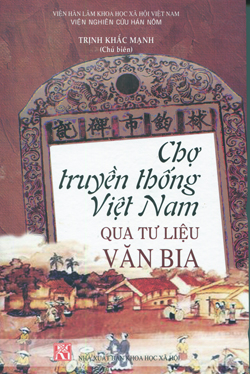 Markets are the places for regular economic, cultural-social exchanges among regions to meet the daily needs of residents and contribute to strengthen community relationships in many regional localities in Vietnam for hundreds of years, and are research subjects for many domestic and foreign scholars. Previous studies often focused on village markets and rural markets. However, in fact, markets did not only exist in the countryside but also in urban areas or in temples and pagodas, therefore the concept of traditional markets is used to cover all aforementioned types of markets.
Markets are the places for regular economic, cultural-social exchanges among regions to meet the daily needs of residents and contribute to strengthen community relationships in many regional localities in Vietnam for hundreds of years, and are research subjects for many domestic and foreign scholars. Previous studies often focused on village markets and rural markets. However, in fact, markets did not only exist in the countryside but also in urban areas or in temples and pagodas, therefore the concept of traditional markets is used to cover all aforementioned types of markets.
The content of the book was presented in 2 parts: 1) Introduction and 66 selectively translated stele inscriptions about traditional markets in Vietnam; 2) Appendix of stele inscription rubbings, selectively translated stele inscriptions which were introduced in an order from 1 to 66, photos in the appendix were numbered corresponding to the selectively translated stele inscriptions. This order was basically classified chronologically in which earlier stele inscriptions were arranged first and later ones were classified behind. Each selectively translated stele inscriptions was divided into 2 parts: One part was transcribed from the original Han characters and the other was the translation. To serve the needs of exploitation of stele inscriptions documentation in Han Nom which wrote about traditional markets in Vietnam, the translating group of Institute for Han Nom Studies collected and translated 92 stele inscriptions, however, due to limited framework of the book, there were only 66 selectively translated stele inscriptions introduced in this book.
Naturally, gathering places appeared as people wished to meet and exchange goods in daily life. Those gathering places could be either big or small but they had to be the most convenient public locations in the region. As time passed, good exchanges took place and became popular, and those places were called markets. However, it had not been able to determine the exact time when traditional markets in Vietnam in medieval period appeared. Stele inscriptions recorded documentation generally as: Markets were the convergences of people and things that were created for people to satisfy their emotional lives; bell was one of the five sounds which Buddha used to transfer merit and belief. Those two things could not be lost. “It was suggested that Le Xa village of Gia Vien district in Truong An was the famous ancient Ai Chau, where there were large-scale markets long time ago.” Or: “Markets were the places for trading and circulation of goods”.
Based on historical documents, the first book about markets in Vietnam, “An Nam tức sự”, was written by Tran Phu (known as Tran Cuong Trung), a Yuan Dynasty ambassador in Vietnam in Tran Dynasty 1293; and kept in the Institute for Han Nom Studies. Markets in Vietnam during this period were described by Tran Phu as “Market fairs were opened every two day with several types of products displayed everywhere. Markets were set up every five miles with a 3-room house and 4-sided pallets.
It was written in Complete Annals of Dai Viet that there was a new rule on opening a market on the 6th October 1477, as known as the 8th year of Hong Duc (1477): "The edict stated that: there was an increasing number of citizens in districts, provinces in many regions in the country, therefore if there was a need to open new markets for trading, government officers in districts, provinces and regions had to examine the actual situations to see whether that would be convenient for citizens and then propose official dispatches to the king; there was no need to inform whether there were markets in those regions or not.”
The main purpose of opening markets was to exchange goods, serve daily needs of citizens. Do Thi Bich Tuyen wrote a dissertation on the topic The study of system of stele inscriptions about markets in Vietnam. The dissertation focused on the following issues: (1) Some general issues about stele inscriptions and those about markets in Vietnam, (2) Characteristics of stele inscriptions about markets (including stele inscriptions about village markets, stele inscriptions about markets in Tam Dao markets, in which the study researched the sizes of stele inscriptions about markets, taboo words and Nom characters on the stele inscriptions about markets, participants who composed stele inscriptions about markets), (3) The disposal of stele inscriptions about markets regarding space and time, (4) Some issues about village markets (including places, scale and the relations between village markets and urban markets), (5) Rules in village markets (including rules about market fairs, goods, rules about managing and collecting taxes and the settlement of disputes between village markets), (6) The value of stele inscriptions to reflect economic activities in rural areas during feudal period (including the reflection of economics activities in rural areas and the culture of te countryside through the opening of markets), (7) Making lists of stele inscriptions about markets with 83 units according to 8 directories and 10 selectively translated stele inscriptions.
Besides the issues that Do Thi Bich Tuyen mentioned in her dissertation, the other authors also complemented some values about history, Tam Giao ideology, experiences of socialization of social resources… that Han Nom stele inscriptions about markets in Vietnam recorded.
Hopefully, this book will provide some useful information for those interested in learning about Vietnam’s traditional markets through stele inscriptions./.
Nguyễn Thu Hà







